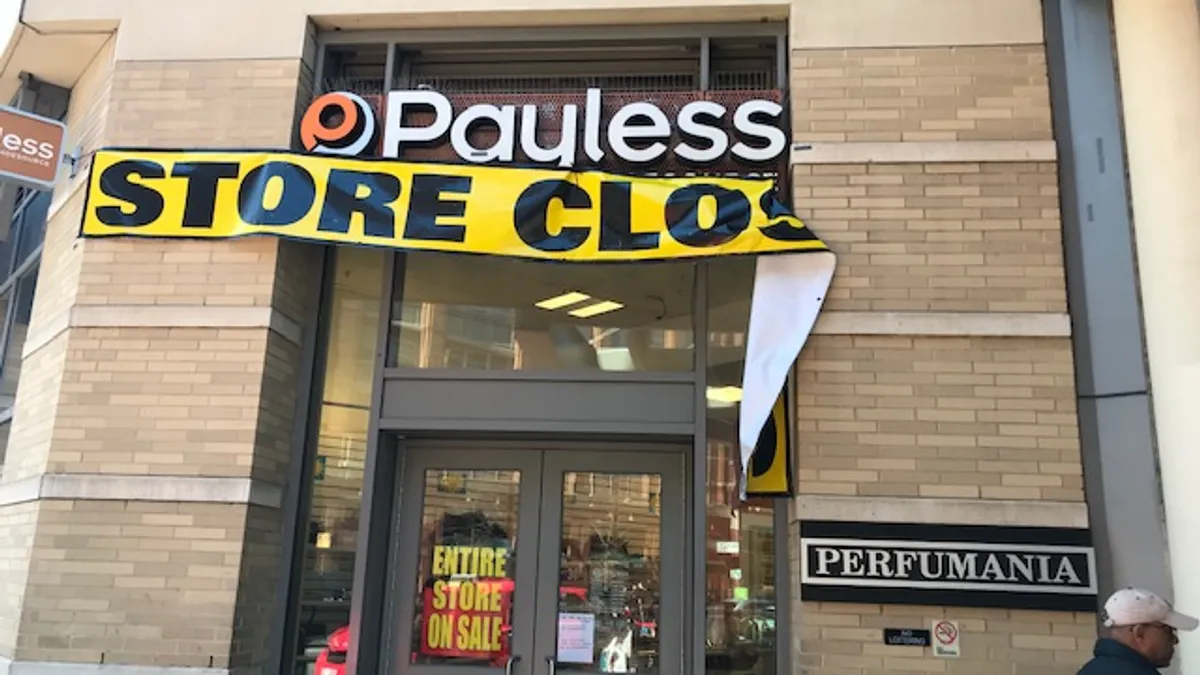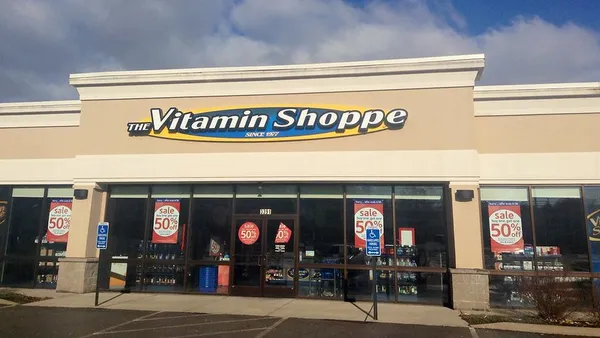When Payless Shoesource exited Chapter 11 in August 2017, it had shed $435 million in debt and hundreds of stores. With a rightsized footprint and balance sheet, executives told Retail Dive at the time the footwear retailer was working to build out omnichannel capabilities such as ship-to-home and pickup-in-store to bring it in line with peers.
The optimism didn't last long. That holiday season, as a restructuring officer would later explain in court papers, a key supplier got behind on shipments, disrupting inventory flows. The next year, a computer breakdown created another crisis during the back-to-school season. Overstock led to discounts on millions of pairs of shoes during this past holiday season. In 2018, Payless's U.S. brick-and-mortar business ran up a loss of $66 million. As of February 2019, Payless had only rolled out those omnichannel improvements — key to surviving in modern retail — to just 200 stores.
When Payless went into Chapter 22 in February, its lenders-turned-owners waved the white flag. Looking at the compounding challenges, they opted to liquidate the shoe retailer's roughly 2,500 North American stores. And just like that, a massive, decades-old retailer was gone. By store count, it was the largest retail liquidation in history — taking two of the largest firms in the market to carry it out — with the inventory estimated at $1 billion.
Payless has company, too. Gymboree (also a Ch. 22 case), Shopko and other retailers have liquidated this year. In May, the chairman of B. Riley Financial, parent of Great American Group, which helped liquidate Gymboree and Payless among others, told investors his company was "the busiest we've ever been in this business." He expected the pace to continue through the year.
"The basic question is, are they worth more alive or dead?"

Josh Friedman
Global Head of Restructuring Data at Debtwire
These are boom times for liquidators, who operate with a mentality in some ways antithetical to mainstream retail. The field is dominated by just a few large players — namely Tiger Group, Hilco Global, Gordon Brothers and Great American — who specialize in winding down large retail chains that have hit the end of the road.
Inventory costs, margins and slick merchandising go out the window as they try to maximize returns on whatever product mix they have to work with. For everyone else, meanwhile, the waves of cheap merchandise flowing from dying retailers puts a crimp on margins. Then again, retail was already tough. If it wasn't, those liquidated retailers might still be around.
Worth more dead?
Companies fated for bankruptcy face three basic outcomes: Reorganize, sell themselves or wind down. Into the latter category go the companies that can't find a buyer or an investor to put up financing for a reorganization.
"The basic question is, are they worth more alive or dead," Joshua Friedman, global head of restructuring data at Debtwire, said in an interview. "Especially if people are going to put up more money. Is this something that's worth doing or not? Should this company still exist? Is there value to the brand? Does it have real assets that are worth something? Are there still people willing to believe in the company and want to be involved in it going forward?"
Liquidating in bankruptcy is the more common outcome. Since 2016 — when retail bankruptcies began to surge — there have been roughly 40 liquidations compared to around 30 reorganizations, Friedman said, based on Debtwire data.
"The biggest factor is when they changed the Bankruptcy Code in 2005," said David Wander, an attorney with Davidoff Hutcher & Citron. "Basically they gave the pen to the creditor lobby."
Prior to that, Wander explains, retailers in bankruptcy could change their inventory mix, store count, suppliers, management team and so on, and had as much as a couple of years to see how those changes affected the top and bottom lines. That timeframe covered multiple business cycles, in a very cyclical industry. That's time to revise projections, if needed, and test new strategies. "Change doesn't happen overnight," Wander said.
Crucially, retailers also had more time to reject leases, giving them ample time to get their store footprint right. That time has been reduced by law to well under a year — 210 days. Before that, retailers could follow the sales trends for a little longer, and exit more leases as necessary.
The shorter timeline also leaves less time to find a potential buyer or investor for a sale or reorganization, and less time for possible buyers and investors to mull a retailer's prospects going forward. That's never an easy task and, as recent history shows, stakeholders often disagree on the value of a retailer and the best way forward.
Toys R Us went into Chapter 11 attempting to reorganize. But it entered bankruptcy unexpectedly, without a plan to reorganize, and couldn't form one months into the process. After an abysmal holiday showing, some creditors started agitating for liquidation even as executives and others pushed to keep the retailer going.
In the case of Bon-Ton, the company landed an interested buyer that would have kept it operating, but a group of second-lien noteholders thought more value could be wrung out of Bon-Ton's inventory and assets. Liquidation, they argued, would also spare them legal and operating expenses. Those creditors got their way when they put together their own bid to buy and liquidate Bon-Ton's assets, which won at a bankruptcy auction.
As Friedman points out, certain lenders down the chain might have an interest in liquidating a retailer. It can provide a cheaper, quicker and more sure path to some amount of repayment on what they're owed, he said. It's also simpler, if the choice is between immediate cash from a liquidation or lenders getting equity in the retailer for debt they hold and waiting for returns on that investment.
Tears in the aisles
Winding down retailers on the scale of Toys R Us, Bon-Ton or Payless takes art and science.
Jack Rapp, executive managing director at Tiger Capital Group, calls it a "very precise business," made so largely because of the experience firms like his have in appraising and liquidating inventory, and the mounds of data they've collected along the way.
But data is just that: data. It's not a crystal ball. "You never really know how a sale is going to do at the end of the day in the final chapter," said Michael McGrail, chief operating officer of Tiger. "It's not like you're looking at previous metrics of anything that is identical. Every retailer is slightly different from each other."
"You couldn't park in the parking lot."

Jack Rapp
Executive Managing Director at Tiger Capital Group
"And it really comes down to what is the core customers' reaction to this [retailer] going away? And how do they react to that with their wallets? It's a hard thing to gauge. Some things exceed expectations, and other things fall massively short of expectations."
One of the main factors driving liquidation sales, McGrail says, is how long the retailer has been in business. Given two retailers, one that's been around for 10 years and another that's been around for 100, "I don't need to know anything about either one of them," he said. The 100-year-old retailer "is going to have much more embedded goodwill in the marketplace and that sale, all other things being equal, should far exceed the other sale. They had a multi-generational client base."
As an example of just how much goodwill a retailer can build up, Rapp notes that when Tiger liquidated the New York department store chain Loehmann's, "there were people literally crying in the aisles." With Toys R Us, after a disappointing round of initial closures, customers flocked to the stores after the toy retailer announced it would shut down entirely. "You couldn't park in the parking lot," Rapp said.
'Pure economics'
The process of running a liquidation is deceptively straightforward, yet it confounds the ordinary logic of retail pricing and merchandising. Where retailers might price by cost and merchandise by the habits of full-price retail, liquidators are tasked with maximizing the total amount they can get for inventory under narrow time constraints.
"A liquidation in and of itself is pure economics, period," said Ben Nicholson, president of Fortis Business Advisors. Nicholson is frequently called in by banks and other stakeholders to liquidate stores that have defaulted or are going out of business.
"If you had a perfect world — which timing never allows this to happen — if I have a markdown of 10%, I would not take another markdown to 20% until the very last item that could possibly sell in that inventory mix at the 10% discount gets sold," Nicholson said. "Then and only then do I mark it to 20%." And so on down the line, with discounts getting steeper and steeper.
That perfect world — where supply and demand are allowed to play out in a vacuum — doesn't exist. For one thing, liquidating retailers are liquidating for a reason: they're out of cash (more or less). And it takes money to keep the lights on and a store staffed during a going-out-of-business sale. In a bankruptcy, creditors are looking to get repaid with the proceeds of a liquidation, so it doesn't do much good to maximize revenue if it gets eaten up by the cost of running the sales.
"Maximum return is not sales," Nicholson says. "Maximum return is sales minus whatever it costs you."
Nicholson says he aims to deliver stores to owners that are empty, all but ready for the next tenant of that space. "I've had last days of liquidation when I've literally looked at somebody and said, 'Give me $5, and whatever you can fill this bag up with, you're out the door with.'"
"I've had last days of liquidation when I've literally looked at somebody and said, 'Give me $5, and whatever you can fill this bag up with, you're out the door with.'"

Ben Nicholson
President of Fortis Business Advisors
That requires a very different mentality from ordinary retailing. To Nicholson and other liquidators, what the retailer originally paid for an item makes no difference in how to price it in a liquidation. Liquidators often say retailers are "married to their merchandise."
"I spent $50 for those orange shoes — I'm not going to take anything less than $50 because I'm not going to lose money on those," Nicholson said, describing a typical retail strategy. "If you try to do that, by the time you get to the end of this thing, those orange shoes are still going to be sitting there."
As Tiger's Rapp puts it, "Our goal is to get this done as quickly and efficiently as possible, even if it means giving up margin dollars, because in the end, the net result is what matters."
That's one reason why liquidators say they're needed to wind down stores, rather than have the retailers do it themselves. Merchandising is different as well. An apparel retailer might organize their stores by designers and other themes, with the hottest (and highest-priced) collections set up front to attract attention and get them out the door while in season.
On the other hand, Nicholson said he will reorganize by size, as aftermarket and off-price outlets might. And the best merchandise? "Back of the store," he says, so that customers have to wade through other merchandise he's trying to clear out before getting to most valuable products in inventory.
Along with operational differences, there are practical reasons liquidators are brought in. As McGrail notes, banks want to make their money back as quickly and efficiently as possible, and at that point they may not trust a retailer whose business has gone into bankruptcy, and who might not be thrilled about their company shutting down.
Competing with a liquidation
For competitors, a retailer in wind-down mode presents both opportunity and headwind — and both can be misestimated.
Liquidating retailers have added thousands of locations to the more than 6,000 store closures announced as of May this year, according to Coresight Research, which estimates 12,000 stores might close in 2019. (The number of store closures is continually ticking upwards.)
When you have that many stores liquidating, "the reality of it is that your share of the consumer wallet is going to be diverted towards those liquidations, which really ... bring margins down," said Debtwire senior retail analyst Philip Emma. "You're competing with the discounts of a liquidation to try to get somebody's attention."
To take one example, Jane Elfers, CEO of The Children's Place, told analysts the apparel retailer took a profit hit from Gymboree going-out-of-business sales to the tune of 95 cents per share, according to a Seeking Alpha transcript. That actually was less than the impact executives expected, though there might still be pain to come. Elfers said that customers stocked up on liquidated Gymboree products that "likely would have been purchased in our stores in Q2."
At the same time, discounting and heated price competition had been going on for years before the spike in store closings. Nicholson points to the rise of Walmart, initiating an era of heavily discounted merchandise. "I don't disagree with the assertion that liquidations are going to rattle the market because it's introducing cheaper goods into the marketplace," he said. "But the bottom line is, the liquidation side of it would not exist if cheap goods weren't coming into the country already."
At the end of the discounting tunnel, there is one less competitor in the world and market share up for grabs, theoretically anyway. The wind down of Toys R Us, for instance, created a scramble among mass merchants, department stores, dollar stores and a host of others trying to get a piece of the toy seller's share. But analysts have noted only about a third of Toys R Us' share was recaptured by other retailers in last year's holiday season.
"You would think J.C. Penney should be benefiting from competitors closing ... but they really haven't."

Philip Emma
Senior Retail Analyst at Debtwire
Just as the downside can be overestimated, so can the opportunity. Sears has been liquidating both in and outside of bankruptcy for years now. In that time, J.C. Penney tried to capitalize on Sears' mass of store closures by entering the appliance category. But while Penney comped in double digits on appliances for a bit, the growth ultimately slowed, and the retailer is already preparing its exit from the category.
Because retailers often build close to each other, closures can have either positive or negative effects, depending on circumstances. The Children's Place specifically targeted Gymboree customers with digital marketing tools in areas where the latter closed stores. But in the case of J.C. Penney and its liquidating peers in the department store space — i.e., Sears and Bon-Ton — the relationship is complex and sometimes symbiotic.
"It's probably a case of the individual mall," Emma said. "What happens to that space? Nobody likes dead space in a mall. Nobody likes dead space in a strip center. If that space gets filled in by somebody else, then the long-term effect is probably minimal. If that mall sort of becomes a ghost town, and you're still sitting in a mall [where] the other anchors liquidated and a lot of the inline stores liquidated — there is an impact from that."
Emma adds that Penney is a "microcosm" of the complex relationship between competitors and their liquidating peers. "You would think J.C. Penney should be benefiting from competitors closing ... but they really haven't," he said. "What gets harder to gauge is, would J.C. Penney's performance have been worse had that not happened?"






















